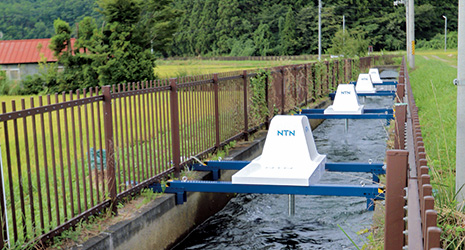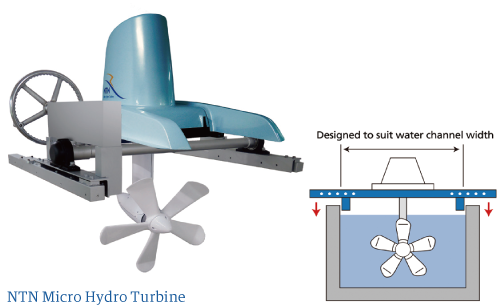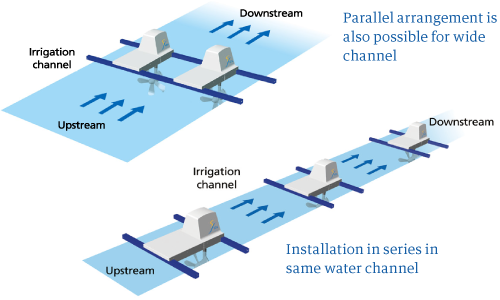Home > Highlighting JAPAN > Highlighting Japan January 2020 > Science & Technology
Highlighting JAPAN


Energy Generation through Water Channels
Small-scale hydroelectric power generators that generate electricity by harnessing the power of water flowing in existing water channels have been attracting attention as a low-cost source of renewable energy.
Hydroelectric power from Japan’s abundant water resources became an important energy source in the Meiji period (1868–1912), when hydroelectric power plants began to be constructed in various parts of the country to support its modernization. Hydroelectric power is a renewable energy that can supply stable power due to relatively small fluctuations in the amount of electricity generated per day and relatively high conversion efficiency. Furthermore, practically no carbon dioxide is emitted during the power generation process.
Hydroelectric power plants often involve the construction of large-scale dams. However, in recent years, small-scale hydroelectric power generation that harnesses the power of water flowing through existing water channels, such as agricultural irrigation channels, has been attracting attention.
According to the Ministry of Agriculture, Forestry and Fisheries, Japan has approximately 400,000 kilometers of agricultural irrigation channels, equivalent to around ten laps of the earth. In addition, it is estimated that more than 10,000 sites across Japan are suitable for small-scale hydroelectric power, including small rivers and streams, water and sewer services, and industrial water channels. NTN Corporation developed the NTN Micro Hydro Turbine to utilize such energy sources that have yet to be tapped.
Katsumata Ryusuke, General Manager of the Engineering Department, Green Energy Products Division, has the following to say about the micro hydro turbine’s features.
“Ordinary hydroelectric generators operate using the difference in water levels created by building dams to generate electricity. This requires flowing water to be dammed upstream, entailing high construction costs. The NTN Micro Hydro Turbine does not require falling water construction and can generate electricity simply by being installed over a water channel. This means it can be introduced at low cost.”
The NTN Micro Hydro Turbine uses running water to turn turbine blades (propellers), which drive a generator that generates electricity. There are three blade diameters: 60 centimeters, 90 centimeters and 130 centimeters. A unit consisting of a power generator and turbine blades is attached to beams suspended over the water channel. Installation of a turbine with a blade diameter of 90 centimeters and weighing about 170 kilos can be completed in around an hour with one mobile crane and three workers. Basically, any channel can generate power, provided that it has sufficient width, depth and flow to install the unit.
“The unique shape of the widened tip of the turbine blades allows water to be collected, enabling highly efficient power generation. In addition, blade tips use a shape called a ‘winglet’ that curves inward, limiting energy loss caused by vortices at the tips,” says Katsumata.
Multiple turbines can also be installed horizontally or vertically to increase the amount of power generation.
According to Katsumata, the NTN Micro Hydro Turbine with a blade diameter of 90 centimeters can generate 24 kWh of power per day in a channel with a flow rate of 2 meters per second. This is equivalent to the daily power consumption of two average households.
Micro hydro turbines can be used to generate power for a variety of uses in local communities, such as pumps, streetlights, greenhouse heating, and other power sources for the private use of farmers, as well as backup power sources for factories and offices.
“Going forward, we will actively promote this technology not only in Japan but also overseas. We are currently receiving many inquiries from rice-producing Asian countries such as Thailand, Myanmar, India and Cambodia. We will continue to improve the product with a view to disseminating small-scale hydroelectric power throughout the world,” says Katsumata.
If small-scale hydroelectric power is adopted more widely, it can limit the amount of energy loss normally incurred during power transmission over long distances from remotely located power stations. Amid the growing importance of measures to address climate change, the NTN Micro Hydro Turbine is expected to promote local production and local consumption of renewable energy, which will contribute to reducing carbon dioxide emissions.


© 2009 Cabinet Office, Government of Japan






